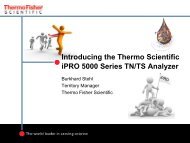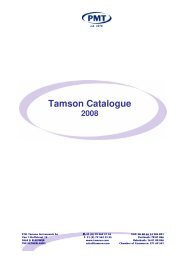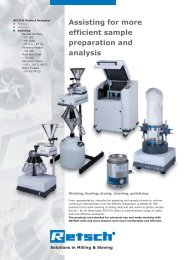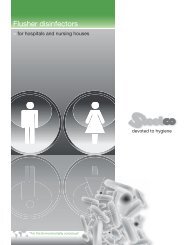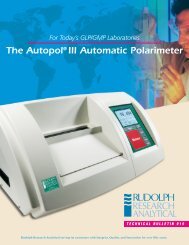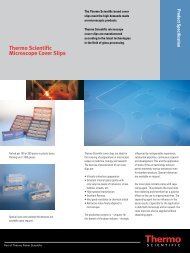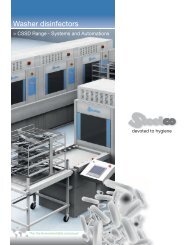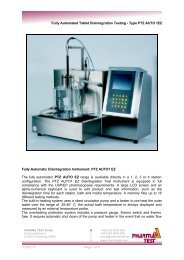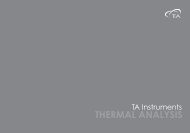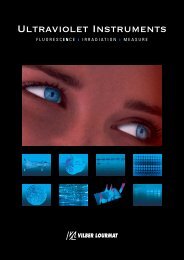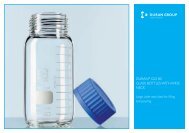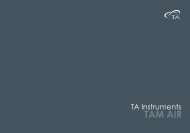Shakers
Shakers
Shakers
Create successful ePaper yourself
Turn your PDF publications into a flip-book with our unique Google optimized e-Paper software.
Growing CHO Cells<br />
This paper is one in a series of guides to growing<br />
cultures in NBS fermentors and bioreactors. For<br />
our other papers on growing mammalian, insect,<br />
bacterial and yeast cultures, please see our website:<br />
www.nbsc.com in the Technical Info section.<br />
Chinese Hamster Ovary cells, or CHO cells, are commonly<br />
used in biotechnology for protein production in the growing sector<br />
of mammalian cell culture. Mammalian cell culture has become<br />
increasingly popular due to the ability of Eukaryotic cells to<br />
achieve more complex post-translational modification of proteins.<br />
Medium:<br />
Many pre-defined media are available for mammalian CHO<br />
cultures from companies such as Hyclone, GIBCO, JRH, and<br />
Sigma. While options exist for media containing serum, the use of<br />
animal component free chemically defined media is quickly becoming<br />
the industry standard.<br />
Batch/Fed-Batch/Continuous:<br />
There are three ways which CHO cells are commonly grown. In a<br />
batch method, all the necessary media and nutrients for the run<br />
are added to the vessel after sterilization and the vessel is inoculated<br />
by adding cells. The cells are allowed to grow until there is<br />
no more available carbon/nitrogen source and they begin to die.<br />
At this point the cells would either be transferred or harvested.<br />
Fed-batch starts out similar to a batch method, but the vessel is<br />
only partially filled with media and nutrients leaving room to add<br />
additional components. When the cells have consumed all available<br />
carbon/nitrogen sources they are fed a supplement and they<br />
continue to grow. This is sometimes repeated several times. In a<br />
continuous system cells are allowed to grow up to a certain<br />
density at which point media is removed and an equal amount of<br />
fresh media is added. Continuous systems can often operate for<br />
very long runs, sometimes over a month.<br />
Typical Process Control Setpoints For CHO:<br />
Temperature........................................................................37°C<br />
pH .........................................................................................7.2<br />
Dissolved Oxygen ...........................................................35-50%<br />
Agitation ................................................................70-130 rpm*<br />
Gas Control .......................................................................4-Gas<br />
Inoculum ..............................................................1.0 - 4.0 x 105<br />
*Agitation ranges will vary depending on the vessel size and the<br />
type of impeller used.<br />
Setpoints for CHO should be entered prior to inoculation, and, except<br />
for DO which often remains high, the media should be allowed<br />
to equilibrate prior to inoculation. DO remains high<br />
because it takes time for the O 2 to permeate out of the media as<br />
it is not yet being utilized by the culture. An initial DO value of approx.<br />
100% air saturation is acceptable and will decrease as the<br />
cells metabolize it. Setpoints are commonly controlled in auto mode.<br />
pH/DO Control:<br />
pH control in animal cell cultures is typically accomplished through<br />
a combination of liquid and gas additions. CO 2 is usually sparged<br />
into the media as a means of lowering the pH and addition of an<br />
alkaline solution, typically sodium bicarbonate solution, is often<br />
made to increase the pH. pH deadbands of 0.1-0.2 may also be<br />
used. These will reduce the volume of base being added.<br />
DO control:<br />
DO control is manually or automatically accomplished by adding<br />
various gasses into the media to either raise or lower the DO. Air<br />
supplementation is most commonly used to maintain and raise<br />
DO. O 2 is sometimes supplemented if air is not capable of control<br />
alone. N 2 is used to reduce the DO level of the media.<br />
Impeller Choices:<br />
Many mammalian cell lines, and CHO in particular, can be grown<br />
using a wide variety of different impellers. Pitched blade and<br />
Marine impellers are popular when growing suspension and<br />
anchorage dependent cells in batch, fed-batch, or perfusion. By<br />
design, these impellers deliver excellent mixing while producing<br />
minimal shear. Filter or screen impellers such as our Spin Filter and<br />
Cell Lift ® are useful when growing cultures where cell-free media<br />
needs to be removed, as either harvest or waste, while cells are<br />
retained within the media. Our Packed Bed Basket impellers use<br />
FibraCel ® Disks as the cell attachment matrix and can produce<br />
very high cell densities as cells grow tightly in or on the fibrous<br />
bed material. This method is most commonly used when secreted<br />
proteins or virus are the desired product. (For more information on<br />
impellers, see page 52).<br />
Typical Cell Densities:<br />
Culture Type Process Average cell<br />
density (cells/ml)<br />
Suspension Batch 2 - 4 x 10 6<br />
Fed-Batch 3 - 6 x 10 6<br />
Perfusion 10 - 15 x 10 6<br />
Microcarrier Batch 2 - 3 x 10 6<br />
Perfusion 10 - 15 x 10 6<br />
Packed-Bed<br />
FibraCel ® Disks Perfusion 0.5 - 1 x 10 8<br />
1.732.287.1200 • 1.800.631.5417 • Fax: 1.732.287.4222 • bioinfo@nbsc.com 43




